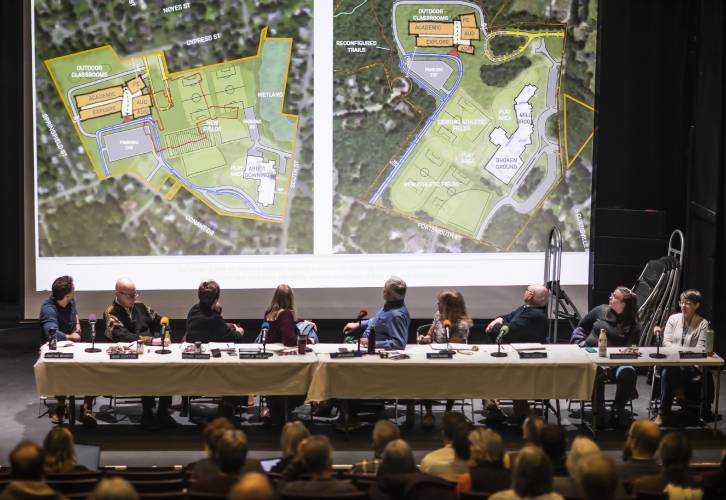Opinion: Insight on the middle school decision

The Concord School Board looks up at the two site plans for the Rundlett Middle School at the opening of the meeting on Wednesday, December 6, 2023. Monitor file
| Published: 08-13-2024 6:00 AM |
Pamela Walsh is President / Member-At-Large, Concord School Board.
I didn’t run for school board because I wanted to build a new middle school. Then and now, I wanted to focus on helping students recover from COVID, improving academics, and carefully using taxpayer dollars.
And while the newspaper headlines are mostly about the middle school, that is what the district has been doing – slowly helping students recover lost learning time; keeping district tax increases well below inflation; and improving academics by returning to phonics in the early years, expanding foreign language at the middle school, and this year implementing a new math curriculum.
But we need a new middle school, and studies done before I joined the board showed that the cost of renovating Rundlett was comparable to building new, without the benefit of a better learning environment.
My initial thought was to just stay at the existing site. But after months of study, I understood why school board members before me had spent so much time looking for alternatives. And that is why last December I joined the majority of the board in concluding that building in the East Side was the best long-term decision. And I think it is important to reiterate some of the reasons why:
■Rebuilding on the Rundlett site will take 18 months to two years longer, and cost taxpayers more.
■A new three-story building on the Rundlett site would have to be placed as close as 30 feet from the back fences of the Springfield Street neighbors, overshadowing their homes and yards, and leaving students with a clear view into people’s homes and yards.
■Construction at the existing site could be as close as 20-30 feet from the existing school. In addition to the disruption to students who will be attending the school at the time (likely the same students who lost kindergarten, first or second grade to COVID), there is a real risk that part of the building would have to come down while it was still in use.
Article continues after...
Yesterday's Most Read Articles
 Sudden pile of trash near Exit 13 on Manchester Street in Concord considered ‘illegal dumping’
Sudden pile of trash near Exit 13 on Manchester Street in Concord considered ‘illegal dumping’
 Motorcyclist being evaluated at Concord Hospital after crash with mail truck
Motorcyclist being evaluated at Concord Hospital after crash with mail truck
 Hometown Hero: Sarah Guinther is ‘changing the world, one cookie at a time’ through the Maddi Hatter Cookie Company
Hometown Hero: Sarah Guinther is ‘changing the world, one cookie at a time’ through the Maddi Hatter Cookie Company
 Merrimack Valley schools to consider eliminating most Penacook bus routes
Merrimack Valley schools to consider eliminating most Penacook bus routes
 Memorial Field Committee inches toward final conceptual plan and will receive more accurate cost estimates on Aug. 12th
Memorial Field Committee inches toward final conceptual plan and will receive more accurate cost estimates on Aug. 12th
 OSHA investigates Pittsfield partial building collapse
OSHA investigates Pittsfield partial building collapse
■The new Rundlett campus would take play space away from Abbott Downing.
And perhaps most importantly it locks the community into a site with no cost-effective options if needs change in the future. When the district consolidated elementary schools they stayed on the Kimball site. I am a proud Christa McAuliffe parent, but it doesn’t have the space for a preschool program, which we are legally required for children 3-5 years old. The playground space is small and exposed. There are no options to expand. The same is true of the high school, where our career technical education program is turning away students.
There are also some myths about the project that I would like to try to dispel. The site is not the city’s Broken Ground Conservation area. The city’s trails will remain, and the design includes providing access to trails from the new site.
The city’s master plan has long called for a pump station upgrade to improve water pressure in the neighborhood, and it would help the district meet fire suppression requirements for the school. But if the city chooses not to move forward, the district has an alternative plan.
Both sites would need changes to infrastructure. At the Rundlett site, Cypress Street would need to be reconfigured to allow it to be the entrance and exit for buses. On the East Side, there may be a need for additional traffic controls, but we will also be able to construct a long drive to take cars off the road. In addition to the fact that the schools start and end at different times, we will also be able to separate the traffic from the existing schools from the middle school.
There has been a suggestion that this will require a major change in transportation. The fact is that the biggest change is what students are bussed. About 85 percent of Rundlett students were eligible to take the bus this year. Although enrollment can vary by year, last year’s 5th-year class at Broken Ground was bigger than the 5th grade classes of Abbott Downing and Christa McAuliffe combined.
The proposed charter amendments would put the district and taxpayers at financial risk. Some have suggested that the district can simply plop the design for the East Side on the Rundlett site. Not true. Passing the first amendment would mean taxpayers will pay a second time for site work, site studies, and designing the building. (In addition to the original additional costs for building at Rundlett and the additional inflation costs of construction delay.)
But most expensively, Concord is grandfathered in at second on the list for state building aid, which would cover up to 40 percent of the project cost. If we are unable to move forward when the state approves funding for building aid, we could find ourselves back at the end of the line.
The second part of the amendment also imposes financial costs on taxpayers. It says the district can’t sell or swap more than an acre of property without a citywide vote. This would require district taxpayers to bear the financial and legal risks of properties it no longer needs and that could be put to other uses. And it could mean taxpayers might not be able to take advantage of good offers that could offset tax bills.
I respect that people of good faith could have come to a different conclusion about the location. But, with no personal stake in the outcome, my colleagues on the board reviewed the data and the options and made the best long-term decision that they could for taxpayers and students, as they were elected to do.







 Opinion: Trumpism in a dying democracy
Opinion: Trumpism in a dying democracy Opinion: What Coolidge’s century-old decision can teach us today
Opinion: What Coolidge’s century-old decision can teach us today Opinion: The art of diplomacy
Opinion: The art of diplomacy Opinion: After Roe: Three years of resistance, care and community
Opinion: After Roe: Three years of resistance, care and community
